Keri Doering
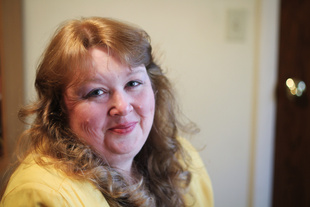
How did you get into costume design?
I was tricked into it.
No, actually, when I was between ten and twelve years old, I was taught by my mother to sew my own clothes, which I did all the way through high school. Later, when I was in college, I began to do quilts, and I continue to enjoy doing a couple of quilts a year.
When my husband and I got married, I knew that David was a big science fiction and fantasy fan. He would often travel to conventions as an aspiring writer and he invited me to go to one of them. It was in Orlando that he introduced me to the world of costume competitions—masquerades, as they call them. He also introduced me to some costumer friends of his—Joyce Best Saunders for one, and she really encouraged me with my quilting background to try to do some costumes.
I enjoyed the idea of creating, so it wasn’t much of a stretch for me to try to create something for the following year’s competition, held in San Francisco. Now, David didn’t mention that you usually start out in this world performing at local events before trying out for an international one, so I had no idea I was trying out my skills on three to four thousand people in a vast auditorium in San Francisco. I had recreated costumes from Disney’s Aladdin, and hearing the audience clap and cheer for us, then having the emcee say that “it’s not right for you to make the emcee cry,” and finally winning an award, got me hooked. It was thrilling.
As friends in Utah learned that I did costumes, I began to get commissions from local theater groups and the like. I even did a costume for Otto Bonn, the mascot for the Water Resources Division of the Utah State Department of Natural Resources.
We understand you were one of the founders of the Utah Costumers Guild. Can you discuss that?
After I had competed and won awards for my costumes in San Francisco and Seattle, I joined the International Costumers Guild—a society of professional and avocational costume designers. The Guild did not have a Utah chapter, and in 1994 some of the other costumers in Salt Lake began asking “why don’t we start one?” I remember Chris Oversby gathering names in support of a chapter. We called a meeting in August of that year and I was honored to be elected their first president at that time.
Through the guild I have met some of the most talented and wonderful costumers in Utah, including Mary Ellen Smith, Cheryl Johnson, Ruth Roper, Susi Geertsen, Kevin Cook, and a host of others. The Guild provides us with both professional support and time to play “dress up.” I am happy to say that our Guild chapter won the right to host the annual Costume-Con, an international-level competition and convention, in 2005. We definitely impressed everyone with our stage at the Egyptian Theater in Ogden. It was the finest venue that they had seen.

Where do you look for inspiration?
There’s inspiration everywhere, just look for it. Sometimes it’s an illustration in a book. Sometimes it’s another costume. Sometimes it’s just serendipity. I’ll be shopping and see a piece of fabric, a brooch, or a hat that just gets me thinking. I like to think of themes that make me happy. Christmastime, for example, makes me happy, so I did a competition outfit based on Christmas. I also love the fall and the sound of leaves under my feet, so I designed an outfit called Lady Autumn that reflects the fall. I also hang around with other creative people—other costumers, authors, singers, and the like. It helps to have a person to bounce ideas off of to get inspiration. (And to tell you when it is just a bad idea!)
Are there certain genres or certain periods that you are particularly drawn to when designing costumes?
I am very fond of the Victorian era, both early and late. I love the classical lines. I love the feeling you get from seeing a person attired that way—there’s a respect, a dignity, an elegant style that princesses wear, much more so than today’s styles.

Can you describe the process of costume design from initial concept to finished product?
I think the process for creating a stage costume for an existing show such as Dracula or Joseph and the Amazing Technicolor Dreamcoat is fairly straightforward. From reading the script to talking with the director and from setting the budget to doing measurements, there’s a lot of pre-existing designs or concepts to work from.
For me, the most challenging process is to do what I call a “competition” outfit—one that I create to compete in an International Costumers Guild event. These are local, regional, and international competitions where designers like me go not only to show off what we’ve created but also to compete for awards. These costumes don’t have a predefined theme, so it is much harder to work through the process to create a winning entry. One example of a costume I made for a competition is called “The Gift,” an ensemble that my husband David and I modeled. That costume actually won the most (and the highest) awards at a single event of any costume that I’ve competed with.
The idea for “The Gift” started at a ward activity, if you can believe it. A musician friend of ours, Mike Whitmore, was performing that night. He used a sort of mushroom light with diamond shapes during his show and the effects on the walls and ceiling were different, colorful, and intriguing. A while later I found some fabric with multicolored diamond shapes on it done in sequins and I knew I had to create something from this fabric.
From there it was a matter of deciding how to present this costume on stage. Part of the judging at international competitions involves the craftsmanship of the costume; the other part is the presentation. I decided to include my husband as part of the presentation, so we brainstormed to come up with a way to present the idea onstage. That’s where David is great, as he has about a thousand ideas an hour—some of which are actually practical!
We knew there was this unwritten rule about performing for competitions: Don’t do onstage changes of costumes. The reason is that stage time is not “real” time. What you think is just a minute onstage is hours to the audience—even thirty seconds is forever for the audience—so changing a costume onstage takes way too long for the audience. Any excitement you might generate from the costume change is lost because the audience is already bored with waiting for your presentation. However, we decided that we might want to bend this rule and try an onstage change by having costumes done first in black and white, and then in full color (including the brilliant sequined fabric). We just weren’t sure how to do it. I finally came up with the solution to use Velcro along with a fold-over panel on my hoop skirt, a set of overpants for my husband, and false vests that converted to capes.
We tried out “The Gift” at a regional competition. We found that we could do the transformation in about ten to twelve seconds, but I wasn’t happy with the way we tried to distract the audience. Watching the video, it felt long. So for the international competition, we included two young friends of ours to hold large plastic crayons, and have them enter from stage left and right while we ducked behind the crayon box backdrop. David and I both raced through our changes so fast that our cue music still hadn’t hit yet; we had managed to change in something like six to seven seconds! The audience laughed and cheered as we reappeared almost magically transformed into what looked like quite different outfits.
Because we came up with such a remarkable solution, we were awarded the very first award of the night—the award for originality, which is only given once a year.
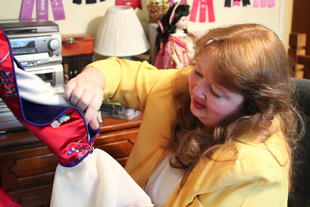
Is the process for costume design any different from that for regular clothing?
Of course! Sure, fitting might be the same for a costume or for street clothing, but the goal of regular clothing is to flatter a person’s figure and provide a comfortable outfit that they can wear in public. For costume design, practicality isn’t the priority. In fact, I once did a costume with a hoop skirt that I could not sit in—I had to have a stool backstage to sit.
Your color palette for costuming is much broader than for contemporary clothing. You are consciously working to either focus the audience’s eyes on a character or to move them into the background. You look for elements that reflect their role in the performance, rather than how a person might perform in their everyday life.
How do you go about breaking down a script in order to determine a character’s personality, circumstance, environment, etc., in order to dress them?
For me it is a matter of reading through the script several times, then consulting with the director for his/her suggestions. When I did the musical Prophet, which was based on the life of Joseph Smith, I was given the freedom to look at non-contemporary colors and fabrics. The director wanted the audience to see the performance as more than just a historical drama, but something more universal. He wanted the characters to have a modern look with a historical feel, so I adapted modern patterns to have a more historical cast with a different cut and fabrics.
What happens when you find a character that you feel you can’t connect with? How do you go about finding inspiration for them?
Actually, this hasn’t happened to me yet. It isn’t necessary that you have a deep connection with the character, but rather a sense of their purpose in the performance. Once I have a sense of the role from reading the script, talking with the director, and then meeting the actor, I feel I have enough of a connection to create a design for them.
It is essential that the actor transform into their character. As a result, it’s quite common for actors to make costume suggestions or even add little touches themselves.
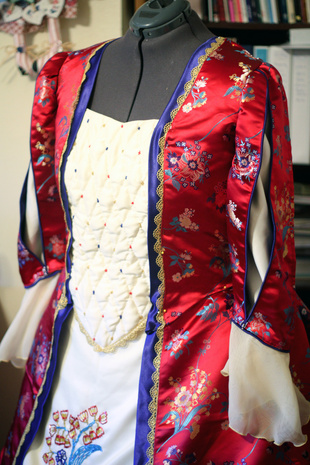
How much creative freedom do you give them with your designs? Do you ever draw the line?
Certainly I draw a line. As I mentioned though, having the actors’ input is important to me. The actors I’ve worked with appreciated my discussing their suggestions with them. I haven’t had any prima donnas get upset or insistent on changes. One time a lead complained about the stiffness of the fabric in one of her costumes, but after consulting with the director we made a change for the rest of the run. I understood her concern and found a way to continue to convey the onstage image with another fabric.
Where would you like to go with your career?
Two words: Edna Mode.
Okay, maybe I won’t be like her character from the movie The Incredibles, but I certainly appreciate her style! I’d love to continue to do costuming for fantasy films. I worked on pre-production for Dave Farland’s Runelords movie and it was thrilling to see my designs come to life in the pre-production artwork.
I’d also like to design clothes for the “traditional build” woman. Too many clothes are designed today for the 8–14 sizes and not for larger women. I’d like to create classical looks that are flattering for these women.
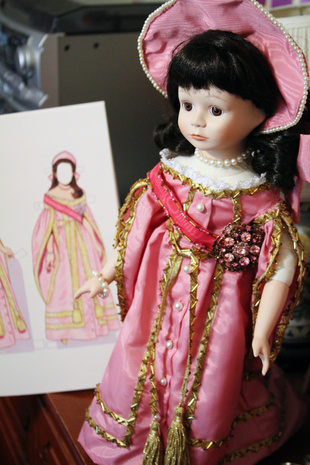
What did you like most about working on the Runelords film?
As I mentioned, it was seeing the conceptual artist take my designs and creating whole scenes with them. It brought them to life! I also enjoyed finding swatches and materials for the outfits, just exploring the possibilities for a lead character’s outfit or the trim on a minor character’s sleeve.
I most enjoyed working with my partner, Mary Ellen Smith. Her years of working with theatrical costumes, eye for color and detail, and boundless energy made those long hours sheer fun. Mary Ellen sees things quite differently than I do, so working together we could get over the problems as we could play off each other.
For example, we were originally only going to do six costume designs, but after we got going, Mary Ellen and I crafted a total of seventeen different costumes for Runelords. It was great fun to bounce ideas off each other and get the synergy going. It got silly sometimes, but even that can be creative. I understand that collaborations can be trying, but I was fortunate to work with Mary Ellen.
Have you seen any areas in your career where your faith has had a positive impact on your work?
You get to know such great people through the gospel and the Church. I have felt encouragement from other members to do costume designs and pursue this career. I also had the rather unique opportunity to do the show Prophet, a musical about the life of Joseph Smith. I was able to combine both my beliefs and my skills to convey the right tone and feeling to the characters onstage so the audience felt all the emotion of the drama. It still brings tears to my eyes as I recall the scenes and music.
Does your religious or cultural background play into your designs? If so, how?
Since I am a lifelong member of the Church, I naturally see things and feel things from that perspective. It isn’t that I consciously try to do LDS-themed costumes, it’s just who I am. I enjoy celebrating with fabric and styles rather than being risqué. I don’t feel I need to push any envelopes to achieve a great effect on stage.
Latter-day Saints are people persons. My husband David is outgoing—sometimes way outgoing—and I’m not. I don’t like to talk like David does. However, in doing costumes, I have to be a people person. I am always thinking in terms of the impact a costume will have on the audience. I am kind of creating a visual conversation with the audience with my costumes.
Since I believe I am a daughter of God, talking to other children of God, I have an approach, a respect for the audience that comes out in my designs and the effect the costumes have on them.
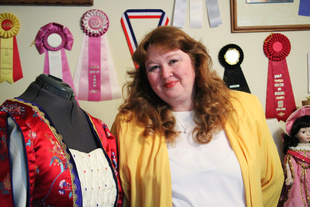
How do you see your work helping build the kingdom?
I see the impact of my work in two ways: personally and professionally. I mentioned the professional part just now—I show the audience, the cast, and the crew that you can have fun, effective, or serious costumes without resorting to the risqué or tasteless. Again, it’s important to me to change the mood of the audience when a character enters on stage—lighter or darker, funny or serious—to move them in some way and not to distract them with the vulgar.
Personally, and to me more importantly, I am one of the very few active LDS members in the International Costumers Guild. Many of these costumers had never met any Latter-day Saints until I came on stage. I feel blessed to have been given this talent, and I openly give credit to Heavenly Father for this. Sometimes mentioning my faith opens up paths to gospel discussions.
Additionally, because God gave me this talent, I have always been willing to teach people how to sew for free. So long as they have the interest, I will teach them. This has opened the door to my home for several people to learn a skill and to feel the Spirit in our home. For example, when my daughter Serena was baptized, many of my non-LDS costume friends came because of our friendship and the warmth they feel when we are together.
I know that many costumers are passionate about their art. As I said, they love to create this visual conversation between the audience and the characters on stage. But that language isn’t one that many Latter-day Saints speak, so I feel blessed for the chance I have to work with many of these people and show them that I too speak their language and they in turn learn that I don’t have horns and that I enjoy having a great relationship with my church as well as with the stage.
I think it is important for us as a people to learn to bridge the gap between us and those who’ve yet to learn about the gospel. We already take time to teach missionaries foreign languages so they can help investigators feel comfortable learning about the gospel.
In the same way, we need to learn to speak the other “languages” of different groups as well. That way they feel comfortable talking with us rather than us making the gospel seem distant and strange.
What has been your favorite design project so far?
The one I am working on right now—that’s always the answer. I have a large outfit in the works on a mannequin in my studio right now and that’s got me excited. ❧
